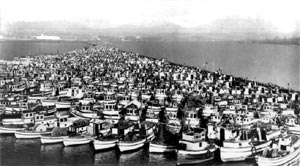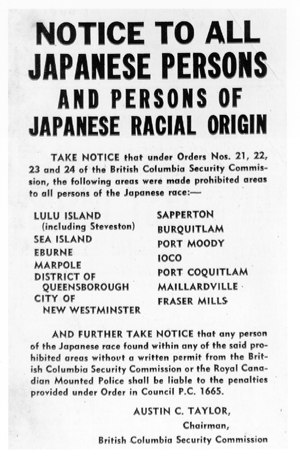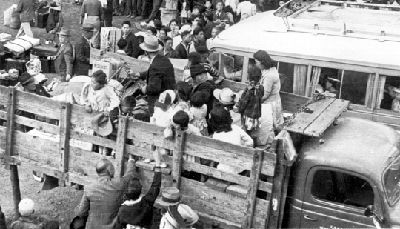Februrary, 1942:The Internment of Japanese Canadians
Prior to World War II, 22,096 Japanese Canadians lived in British Columbia. After the devastating attacks on Pearl Harbor and Hong Kong people on the West Coasts of Canada and the United States were seized by fear and paranoia over a possible Japanese attack. Panicked populations demanded that their governments deal with the "Japanese menace". In Canada, the RCMP quickly arrested suspected Japanese agents and the Royal Canadian Navy seized over 1200 Japanese-Canadian fishing boats.
On 24 February 1942, the federal Cabinet of Prime Minister William Lyon Mackenzie King issued Order-in-Council P.C. 1486 to remove and detain "any and all persons" from any "protective area" in the country. This was specifically used to target Japanese Canadians along the West Coast. The following week, the British Columbia Security Commission was established to carry out the internment of Japanese-Canadians. Japanese-Canadian detainees were given the choice of moving to remote towns in the BC interior or working on sugar beet farms in Alberta and Manitoba . Those who resisted their internment were sent to prisoner of war camps in Ontario.


These Japanese Canadians lost everything - their jobs, their homes, their communities. No person of Japanese race born in Canada was charged with any act of sabotage or disloyalty during the years of war.
In 1949, four years after the war was over, all the restrictions were lifted and Japanese Canadians were given full citizenship rights, including the right to vote and the right to return to the West Coast. But there was no home to return to. The Japanese Canadian community in British Columbia was virtually destroyed.
To learn more about this shameful moment in Canada's history, go to: http://www.thecanadianencyclopedia.ca/en/article/japanese-internment-banished-and-beyond-tears-feature/ http://www.japanesecanadianhistory.net/the_war_years.htm